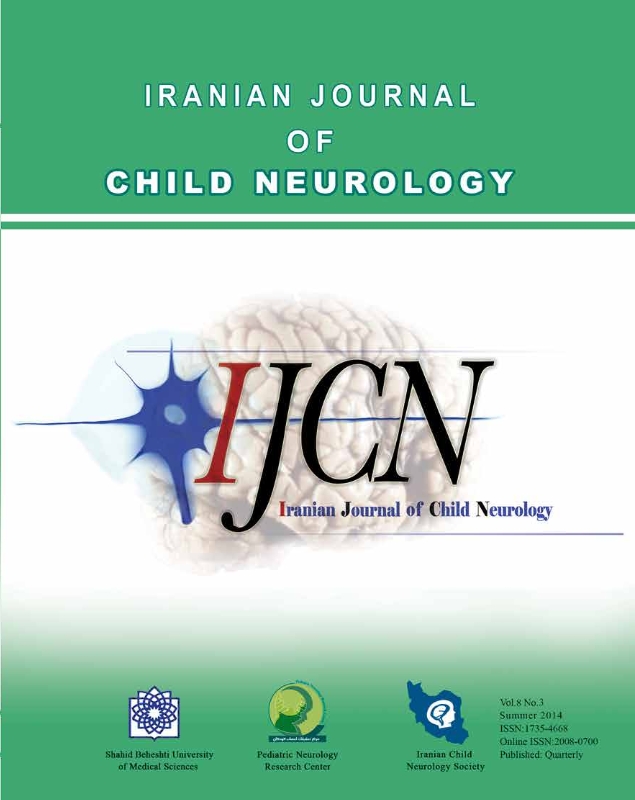Infantile Spasm: A Review Article
Iranian Journal of Child Neurology,
Vol. 8 No. 3 (2014),
1 July 2014
,
Page 1-5
https://doi.org/10.22037/ijcn.v8i3.5476
Abstract
How to Cite This Article: Taghdiri MM, Nemati H. Infantile Spasm: A Review Article. Iran J Child Neurol. 2014 Summer;8(3): 1-5.
Abstract
Objective
Infantile spasm (IS) is a convulsive disease characterized by brief, symmetric axial muscle contraction (neck, trunk, and/or extremities). IS is a type of seizure that was first described by West in 1841, who witnessed the seizure in his own son. West’s syndrome refers to the classic triad of spasms, characteristic EEG, and neurodevelopmental regression. Most cases involve flexors and extensors,
but either of the types may be involved independently.
IS, as its name implies, most often occurs during the first year of life with an incidence of approximately 1 per 2000-4000 live births. Most, but not all, patients with this disorder have severe EEG abnormalities; this pattern was originally
referred to as hypsarrhythmia by Gibbs and Gibbs. Cases with known etiology or signs of brain damage are considered as symptomatic. The Overall prognosis of the disease is poor. Peak onset age of the epileptic syndrome is 3 to 7 months, which mainly occurs before 2 years of age in 93% of patients. Hypsarrhythmia is the EEG hallmark of IS, which comprised a chaotic, bilaterally asynchronous high-voltage polyspike, and slow wave discharges interspersed with multifocal spikes and slow waves.
Etiological classification is as follows: 1) Symptomatic: with identifiable prenatal, perinatal, and postnatal causes with developmental delay at the presentation time; 2) Cryptogenic: unknown underlying cause, normal development at the onset of spasms, normal neurological exam and neuroimaging, and no abnormality in the metabolic evaluation; 3) Idiopathic: pure functional cerebral dysfunction with complete recovery, no residual dysfunction, normal neuroimaging and normal etiologic evaluation, and normal neurodevelopment.
References
- Infantile Spasms. In: Jean Aicardi: Disease of Nervous system in childhood. 3th ed. Mac Keith pres; 2009. p. 593-7.
- Fujii, Oquni H, Hirano Y, Shioda M, Osawa M. A longterm, clinical study on symptomatic infantile spasm with focal features. Brain Dev 2013;35(5):379-85.
- SankarR, Koh S, Wu J. Menkes JH. Paroxysmal disorders. In: Menkes JH, Sarnat HB,. MariaBL, editors Child neurology. 7th ed. Philadelphia: Lippincott Williams & Wilkins; 2006. p. 857-942.
- Kendall Nash and Joseph Sullivan. Myoclonic seizures and infantile spasms. InSwaiman KF, Ashwal S, Ferriero DM, Schor NF, editors.. Swaiman’s pediatric Neurology: principles and practice. 5th ed. Edinburgh: Elsevier Saunders; 2012. p. 774-89.
- Paroxysmal Disorders. In: Piña-Garza J. Fenichel’s Clinical Pediatric Neurology. 7th ed. Elsevier Saunders; 2013. p. 1-46.
- Paciorkowski AR, Thio LL, Dobyns WB. Genetic and biologic classification of infantile spasms. Pediatr Neurol 2011;45(6):355-67.
- Manqanno S, Nardello R, Tripi G, Giordano G, Spitaleri C, Manfano GR. West Syndrome Followed by juvenile myoclonic epilepsy: a coincidental occurrence. BMC Neural 2013;13:48.
- LUX AL. Latest American and European update on infantile spasms. Curr Neural Neurosci Rep 2013;13(3):334.
- Hrachovy RA, Frost JD Jr. Infantile spasms. Handb Clin Neuro. 2013;111:611-8.
- Shumiloff NA, Lam WM, Manasco KB. Adrenocorticotropic hormone for the treatment of west syndrome in children. Ann Pharmacother 2013 47(5):744- 54.
- Wheless JW, Gibson PA, Rosbeck KL, Hardin M, O’Dell C, Whiltemore V. Infantile Spasms (west syndrome): Update and resources for pediatricians and providers to share with parents. BMC Pediatr. 2012;12:108.
- Watemberg N. Infantile Spasms: treatment challenges. Curr Treat Options Neural. 2012;14(4): 322-31.
- Fukui M, Shimakawa S, Tanabe T, Nomura S, Kashiwagi M, Azumakawa K. Partial seizures during ACTH therapy in a cryptogenic West syndrome patient. Brain Dev 2013;Pii:s0387-7604(13)00003-x.
- Friedman D, Boqner M, Parker-Menzer K, Dviskyo. Vigabatin for partial- onset seizure treatment in patients with tuberous sclerosis complex. Epilepsy Behav 2013;27(1):118-20.
- Bilton JY, Sauerwein HC, Wiss SK, Donner EJ, Whiting S, Dooley JM, et al. A randomized controlled trial of flunarizine as add-on therapy and effect on cognitive outcome in children with infantile Spasms. Epilepsia 2012;53(9):1570-6.
- Pires ME, IIea A, Bourel E, Bellaroine V, Merdariv D, Berquin P. Ketogenic diet for infantile spasms refractory to first-line treatment: An open prospective study. Epilepsy Res 2013; 105(1-2): 189-94.
- Vykuntaragu KN, Bhat S, Sangay KS, Govindaagu M. Symptomatic West syndrome Secondary to Glucose transporter-1 (GluT1) Deficiency with complete response to 4:1 Ketogenic Diet. Indian J Pediatr 2013. [Epub ahead of print]
- Taghdiri MM, Comparative effects of Nitrazepam and ACTH on the treatment of infantile Spasms. Iran J Child Neurol 2007;1(4):25-30.
- Taghdiri MM, Presentation of 60 cases of infantile spasms based on etiology, clinical manifestation, EEG and brain CT scan in Mofid Children’s Hospital. JRehab 2002;3(8- 9);39-42.
- Taghdiri MM. Report of 40 cases of Tuberous sclerosis in Tehran. Scientific Journal of Hamadan University of Medical sciences 2002;9(1):63-7.
- Mytinger JR, Joshi S; Pediatric Epilepsy Research Consortium, Section on Infantile Spasms. The current evaluation and treatment of infantile spasms among members of the child Neurology Society. J child Neural 2012;227(10):1289-94.
- Hancock EC, Osborne JP, Edwards SW. Treatment of infantile spasms. Cochrane Database Syst Rev 2013;6:CD001770.
- Infantile spasms
- Electroencephalography
- hypsarrhythmia
How to Cite
- Abstract Viewed: 742 times
